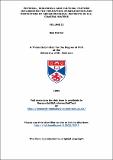Files in this item
Physical, biological and cultural factors influencing the formation, stabilisation and protection of archaeological deposits in U.K. coastal waters
Item metadata
| dc.contributor.advisor | Martin, Colin | |
| dc.contributor.author | Ferrari, Ben | |
| dc.coverage.spatial | 2 v. (630 p.) | en_US |
| dc.date.accessioned | 2012-07-12T14:02:38Z | |
| dc.date.available | 2012-07-12T14:02:38Z | |
| dc.date.issued | 1995 | |
| dc.identifier.uri | https://hdl.handle.net/10023/2971 | |
| dc.description.abstract | A considerable corpus of information regarding the formation of terrestrial archaeological deposits exists which is not matched by studies of deposit formation in coastal waters. Similarly, there is a disjunction between strident calls for minimal disturbance investigation, with conservation in situ, and knowledge of how this might actually be achieved in the marine environment. The manner in which the investigation of deposit formation can complement the study of in situ conservation is considered An approach is proposed which combines selected elements of Schiffer's Transformation Theory with a method of studying changes to deposits outlined by Wildesen. It is suggested that, although sufficient regularities can be detected in the influence of formation processes to allow their influence to be recognised and inference refined accordingly, there are case specific limitations on the extent to which the precise influence of each process can be described and evaluated. A case study is presented which investigates casual depredation as a formation process. Commercial fishing activity and marine burrowing activity are the subject of detailed consideration. New insights into these processes result from this study and specific recommendations concerning in situ conservation of deposits subject to their influence are made. The need to consider fishing practice as well as the mechanical properties of fishing gear in the study of deposit formation and protection is emphasised. The excavation of a 16th century wreck in Studland Bay, Dorset, is used to demonstrate the pervasive influence of burrowing activity and the problems associated with mitigation of this process. Recommendations are made regarding future study of formation processes and the development of policy related to the management of the submerged archaeological resource. | en_US |
| dc.language.iso | en | en_US |
| dc.publisher | University of St Andrews | |
| dc.subject.lcc | CC77.U5F3 | |
| dc.subject.lcsh | Underwater archaeology--Europe | en_US |
| dc.title | Physical, biological and cultural factors influencing the formation, stabilisation and protection of archaeological deposits in U.K. coastal waters | en_US |
| dc.type | Thesis | en_US |
| dc.type.qualificationlevel | Doctoral | en_US |
| dc.type.qualificationname | PhD Doctor of Philosophy | en_US |
| dc.publisher.institution | The University of St Andrews | en_US |
This item appears in the following Collection(s)
Items in the St Andrews Research Repository are protected by copyright, with all rights reserved, unless otherwise indicated.


